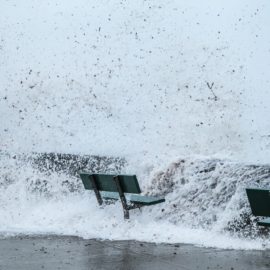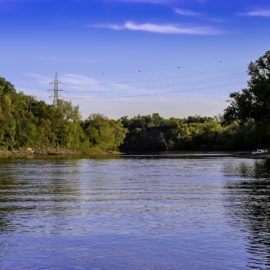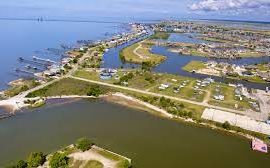
When the spillway opens we thing of people but this time it is the fish.
A federal judge has ordered the Army Corps of Engineers to consult with federal wildlife officials on the impact the opening of the Bonnet Carre Spillway has on fish habitat. The order, handed down on Wednesday by U.S. District Judge Louis Guirola Jr., based in Gulfport, Miss., is part of a broader damages lawsuit filed by Mississippi Gulf Coast local governments, fishers and vacation businesses in 2019 against the Corps and the Mississippi River Commission. The lawsuit charges they violated federal environmental laws in allowing the diversion’s freshwater and nutrients to disrupt fishing in Mississippi Sound. Guirola, appointed by President George W. Bush, said the plaintiffs in the case “have demonstrated that the Corps created an increased risk of actual, threatened, or imminent environmental harm” when the spillway was opened without consulting with NOAA’s National Marine Fisheries Services. He said future consultation “may well require the Corps to consider alternatives” that would lessen environmental harm to the Mississippi plaintiffs. Under the ruling, the Corps must consult with the fisheries service about the impact of opening the spillway on essential habitat for fisheries by Sept. 30.
nola.com
The openings in question were in 2019.
In 2019, the spillway was opened twice for a total of 123 days, which, combined with other flooding issues, resulted in a federal fisheries disaster declaration and the distribution of $88 million in federal relief payments. The higher freshwater content in the sound killed oysters and pushed other commercial fish species offshore. Nutrients from the river caused harmful algae blooms that forced state officials to close Mississippi beaches to swimming. Allegations that the Corps and commission violated the federal National Environmental Policy Act were dismissed by Guirola in September 2021 on procedural grounds. That decision is still being considered on appeal by the U.S. 5th Circuit Court of Appeals.
Each opening is a discrete event and you can’t combine openings.
In his decision Wednesday, Guirola ruled against the Corps’ arguments that the spillway, built after the 1927 Mississippi River flood, predated congressional approval of either the Endangered Species Act, or the Magnuson-Stevens Act, which requires protection of “essential fish habitat” used by endangered and threatened species, and thus should not be governed by them. Instead, he agreed with the Mississippi parties that each opening of the spillway should be considered a separate action governed by the federal laws, and that the Corps should have consulted with the fisheries service as part of its opening decision. “The Corps does not appear to dispute that the Mississippi Sound, Lake Pontchartrain, and Lake Borgne have been designated as essential fish habitats,” Guirola wrote in his decision. And Mississippi witnesses provided ample evidence “that the spillway openings had adverse effects on the essential fish habitats in these waters.”
It was not just Mississippi but also Louisiana that was impacted.
Robert Wiygul, an attorney representing the Mississippi parties, pointed out that the spillway’s damage to fish included those in Louisiana waters. “I think the big question here is whether the Corps wants to take advantage of this opportunity to address the river’s water quality issues,” he said. The Corps has been conducting a study for several years aimed at recommending how better to divide the flow of the river among present and future spillways and diversions from Cape Girardeau, Mo., to the Gulf. In December, Congress authorized the study — officially known as “Lower Mississippi River Comprehensive Management Study” — to be fully funded by the federal government. Louisiana officials hope it can both help long-term efforts to find ways of increasing the flow of sediment into rapidly eroding wetlands along the coast, while also reducing the flow of water in the Bonnet Carre Spillway during high-river periods.
Can other spillways be used to relieve the flow here?
It is expected to address whether the Old River Control Structure above Baton Rouge or the Morganza Spillway, both of which dump water into the Atchafalaya River watershed, can be better used to reduce water flows along New Orleans without causing increased flooding in Morgan City. A Corps spokesperson said requests for comments on the ruling should be addressed by the U.S. Department of Justice. A query to the Justice Department was not responded to on Thursday. “We are aware of the decision and are prepared to discuss with the Corps how to respond to it,” said Allison Garrett, a spokesperson for NOAA, the parent agency of the fisheries service.
River flow at Carrollton determines when the spillway is opened.
The Corps generally decides to open the Bonnet Carre Spillway when the flow of water at the Carrollton Gauge in New Orleans reaches 1.25 million cubic feet per second and is increasing. On average, the spillway has been opened every six years since it was completed, but six of its 15 openings occurred after 2011, and four openings occurred between 2018 and 2020. Plaintiffs in the lawsuit include the cities of Biloxi, D’Iberville, Diamondhead, Pass Christian, and Waveland, Hancock and Harrison counties, Mississippi Commercial Fisheries United Inc. and the Mississippi Hotel and Lodging Association. Louisiana asked to intervene in the suit in 2019 to protect its interests, and has been considered as a defendant, though the judge’s ruling does not impact the state. “We are reviewing the opinion and considering its implications and next steps,” said Marina Clay, a spokesperson for Louisiana’s Coastal Protection and Restoration Authority, responding to a request for comment on the decision.
Salt water fish do not like fresh water.



